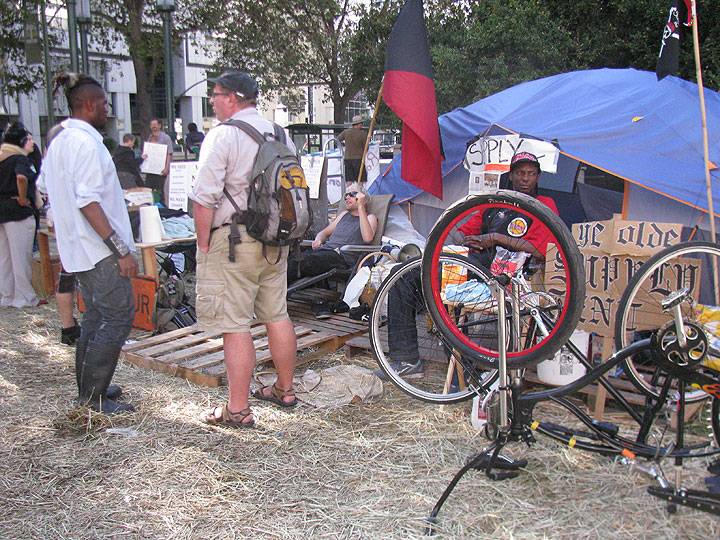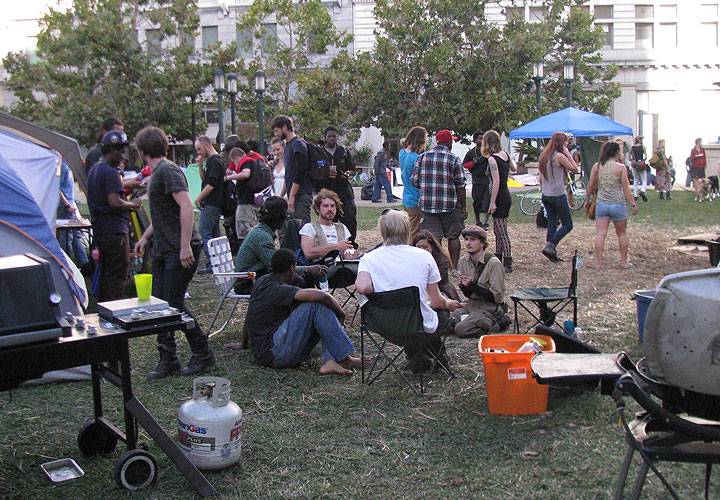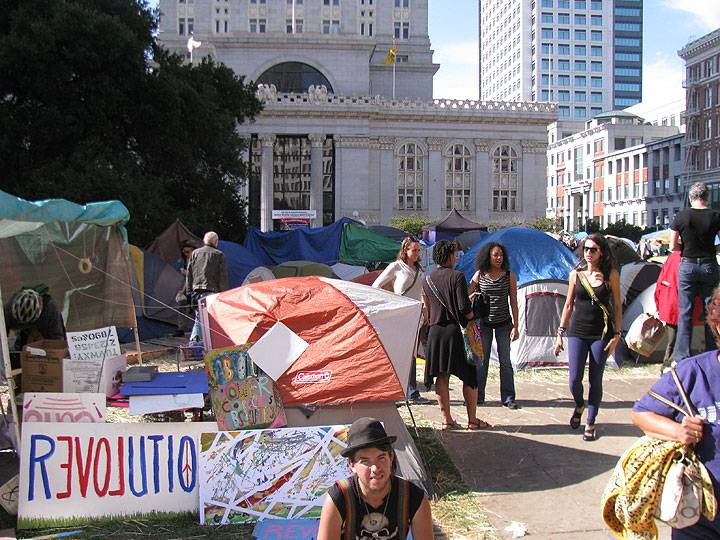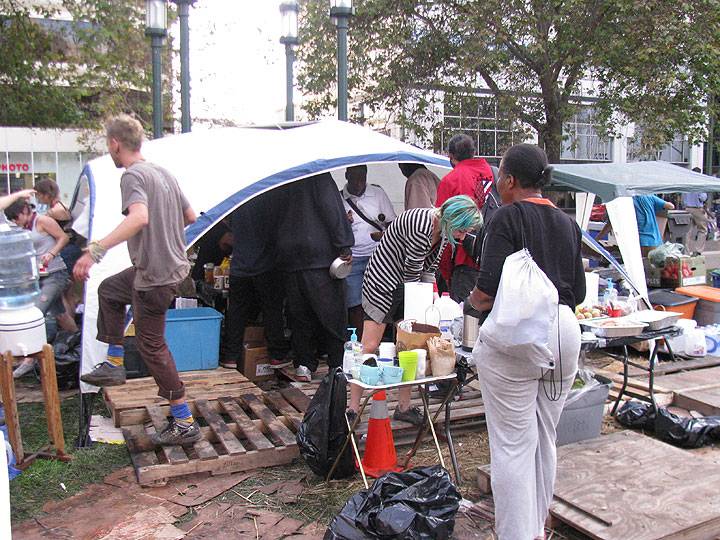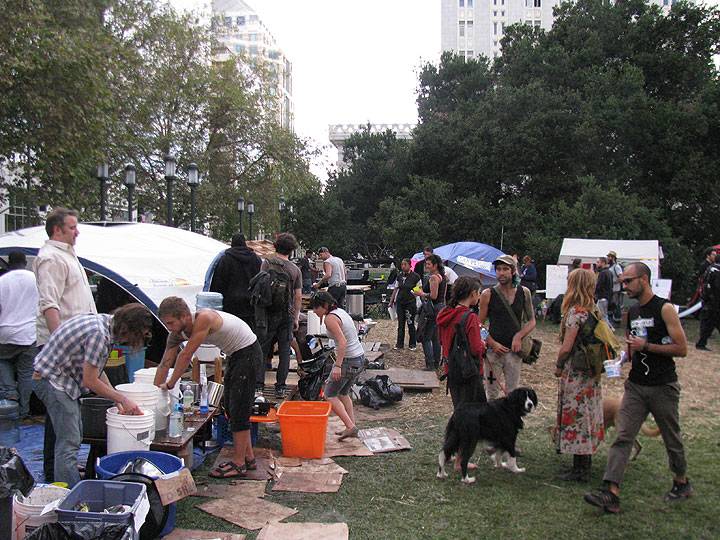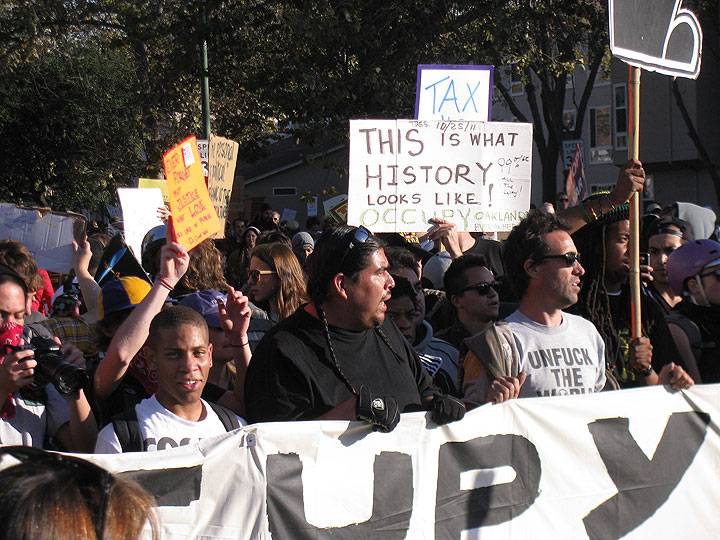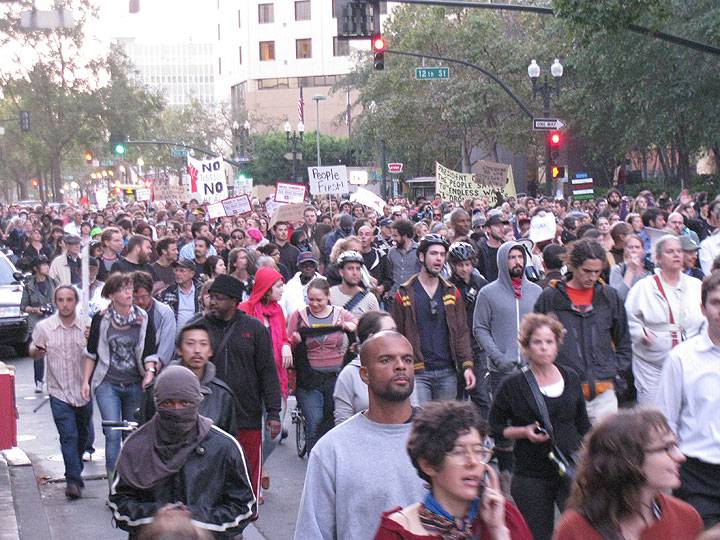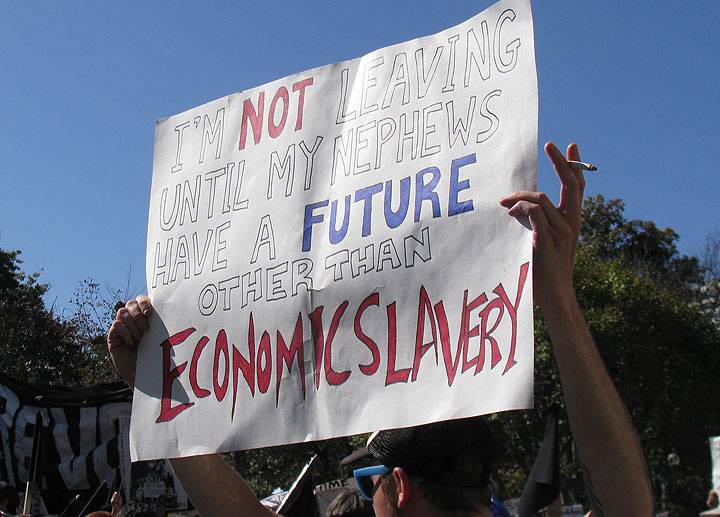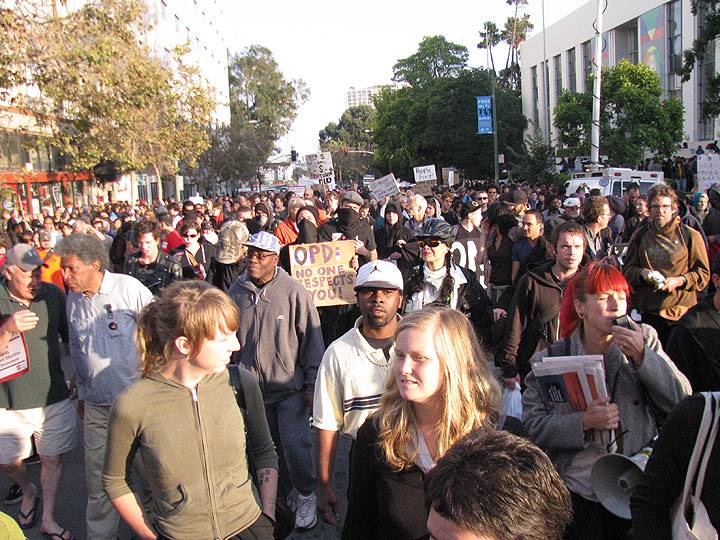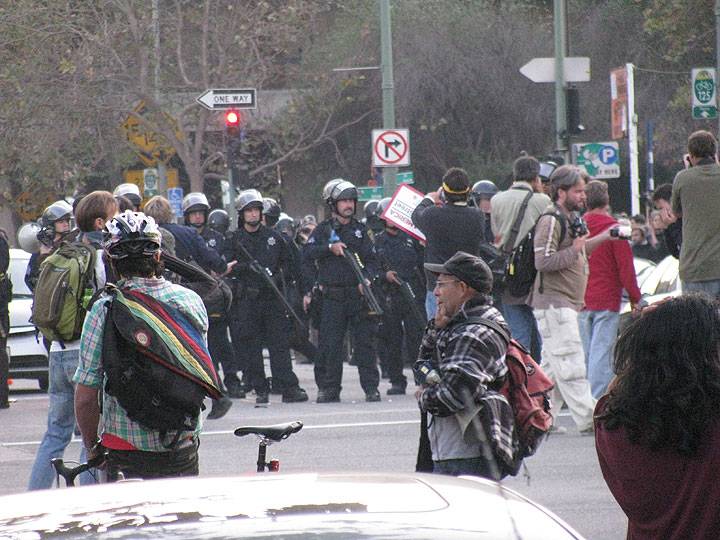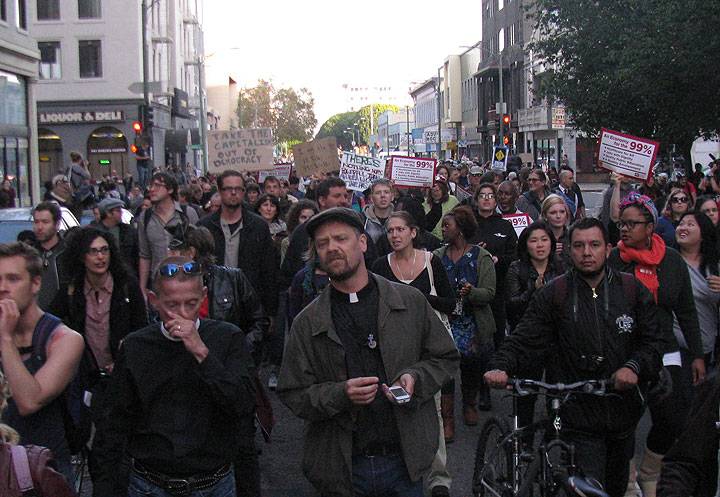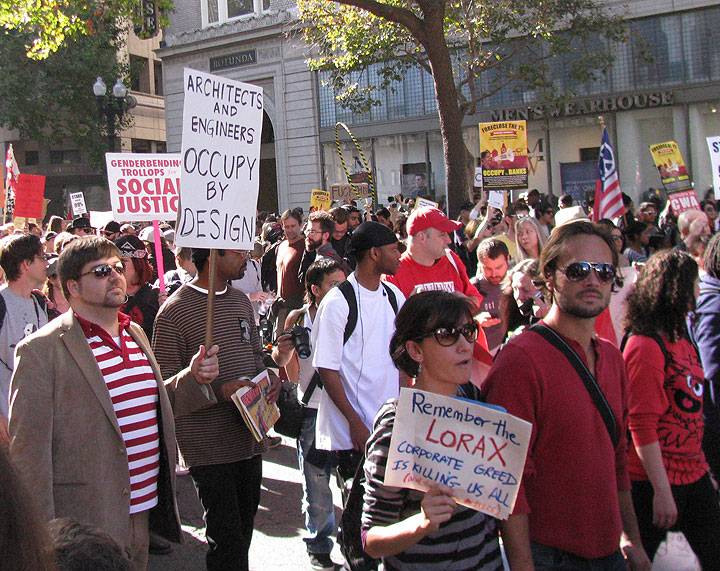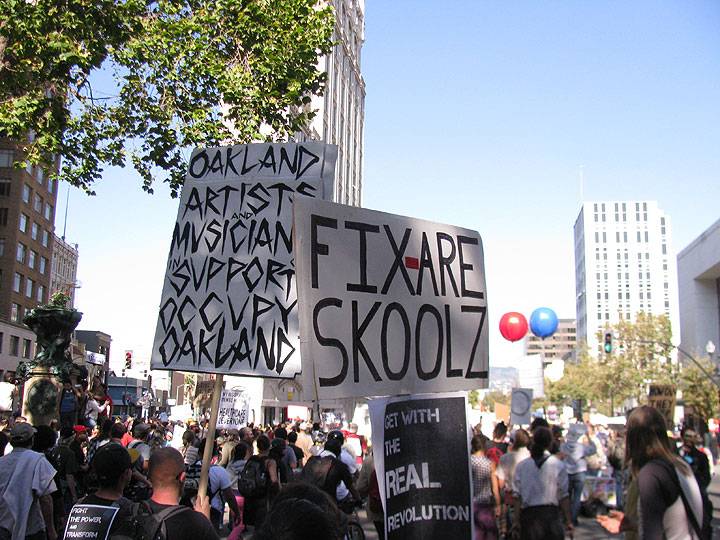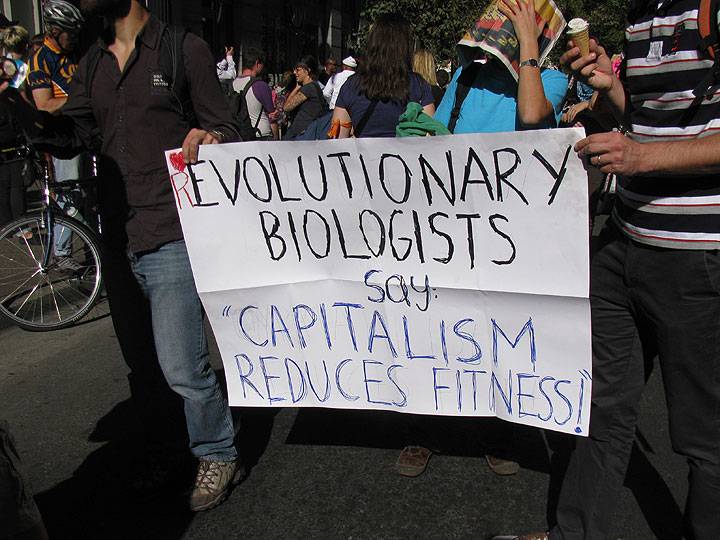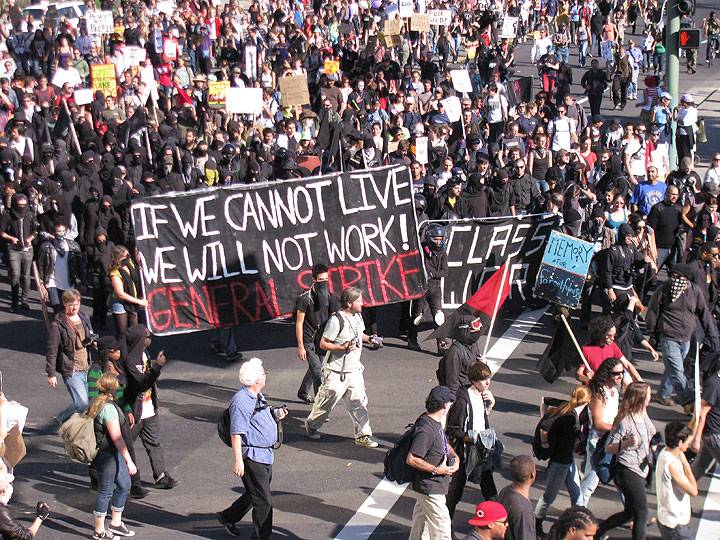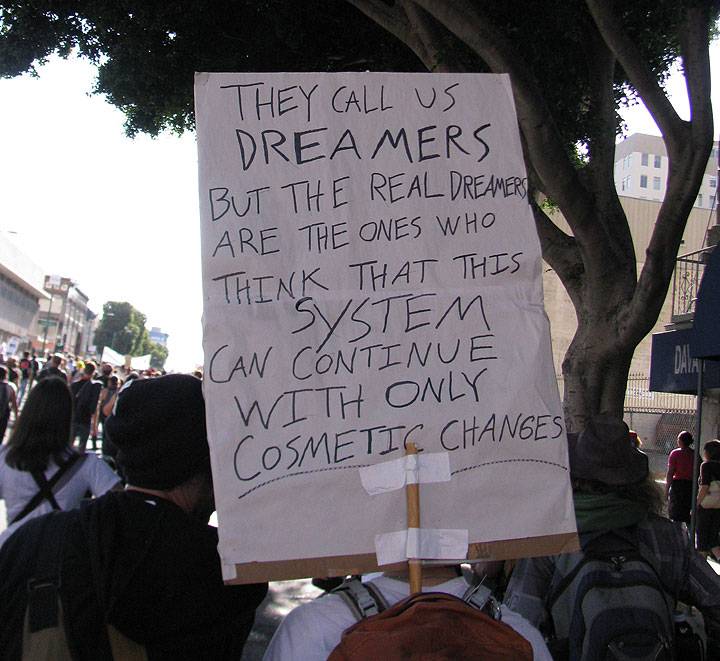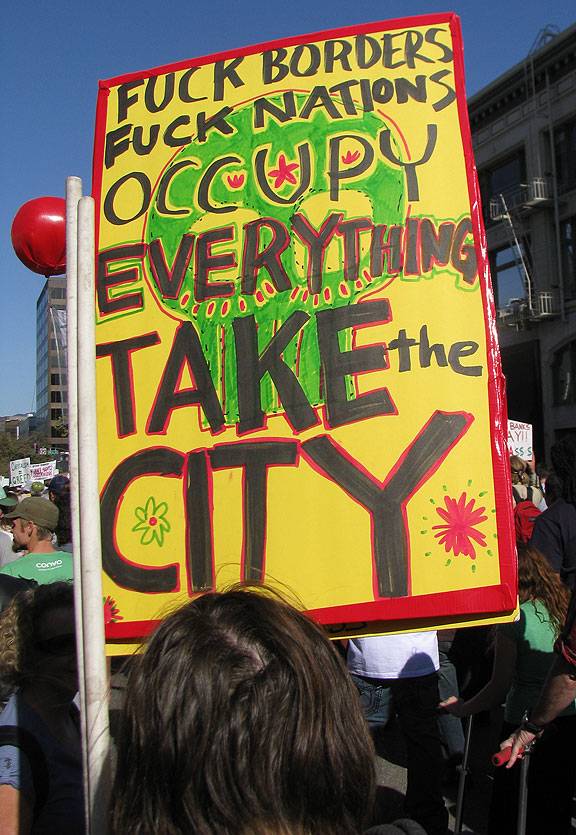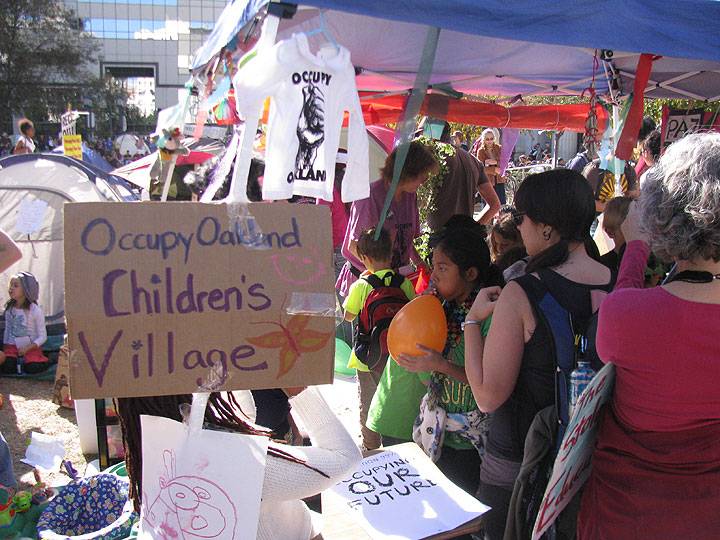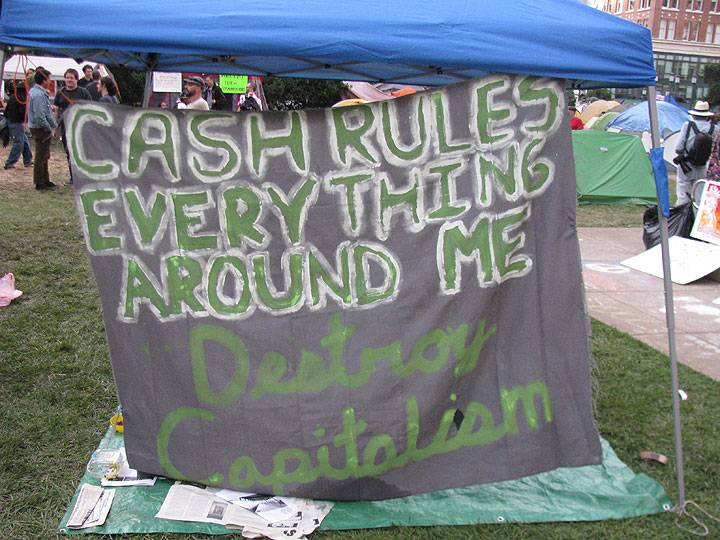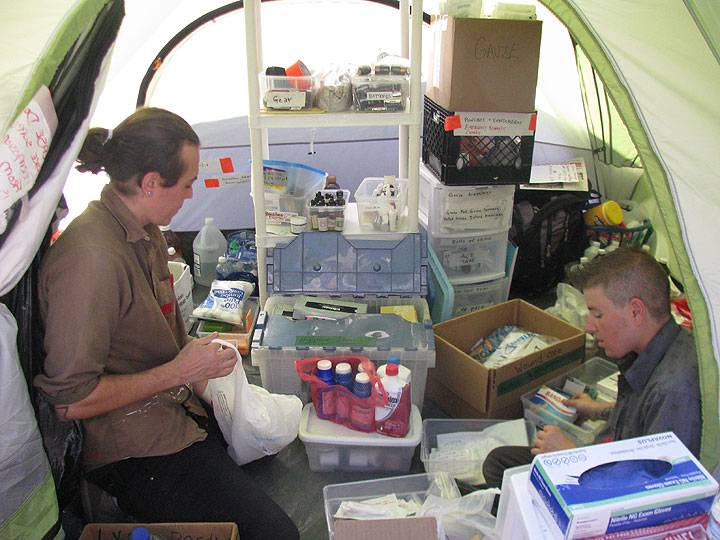Occupy Oakland
"I was there..."
Originally published as "The Hungry Got Food, the Homeless Got Shelter" in California Northern magazine, Issue 5.
By D. Scot Miller
October 15, 2011, Occupy Oakland, Oscar Grant Plaza, in front of the supply tent.
Photo: Chris Carlsson
| As a person who was initially skeptical of the Occupy movement, D. Scot Miller became an active participant in the movement of 2011. Miller highlights the otherwise unknown disparity between the skewed images portrayed by the media and the ambience experienced on the ground. The people of the Occupy Oakland movement were able to create a functioning society without currency, by a multiracial coalition, and a space that drew people in and attended to their needs without discrimination. After the police raid of Oscar Grant Plaza, the movement gained international attention, and the main focus became to defend that location. A General Strike followed, shutting down the Port of Oakland, but also marking Miller's last involvement in the direct action of Occupy. |
I am underemployed. I’m a part-time creative writing teacher, a freelance writer and curator, a part-time bartender, and a bookstore clerk. In short, I have no money.
Prior to the Occupy movement, I hadn’t found adequate employment for nearly six years. I had worried about my increasing disenfranchisement to death, to no avail. I had considered who might be responsible, but found no clues as to the mystery of my terminal underemployment. Like so many others, I had stopped thinking about upward mobility. The concept had been demolished by part-time jobs and increasing survival debt.
Finally, when I saw other people crawling from their hiding places to make some noise about their own struggles in Occupy demonstrations and encampments all over the world, I began to understand my situation. Only then did the mainstream media begin dropping statistics like this one, released by the United States Congressional Budget Office: over the last thirty years, the income of the top 1 percent of Americans increased by 275 percent, while the bottom fifth saw an increase of just 18 percent.
Constant discussion characterized the Occupy Oakland camp, seen here Oct. 15, 2011.
Photo: Chris Carlsson
Last October, my life’s main concern was finding a theme for a zine I was making. A friend named Flea asked me if I was going to the Occupy Oakland protest, and if I was, she wanted me to help her make a sign. I hadn’t planned on going, but her request gave me an idea: I had my theme. In lieu of a sign, I would hand out copies of my new protest-themed zine. I went to work gathering content for it.
I work part-time at City Lights Bookstore, which is a blessing in so many ways. For instance, I had access to both incendiary literature and a copy machine. I pulled text from the Invisible Committee’s The Coming Insurrection, CrimethInc’s Days Of War, Nights Of Love, and Hakim Bey’s T.A.Z.: The Temporary Autonomous Zone, threw in some quotes from Frantz Fanon, and drew a picture of a car careening off a cliff next to the words “Where Do We Go From Here?”—an homage to Martin Luther King, Jr.’s book of the same name.
It was raining when Flea and I got to the first day of Occupy Oakland. Being an Oakland local, I saw a lot of people I knew, including writers, artists, activists, and a friend I had known for nearly twenty years who appeared to be a central figure. As a cook, carpenter, and community organizer, his skill set made him perfect for the position. He waved me over and I began helping him carry tents, sleeping bags, and food while we caught up. After talking with him for a while, I realized that he was deeply invested in what was happening here. Though I’d been less than impressed by the impetus for the Occupy movement—it was originally organized by the often gimmicky and unfocused magazine Adbusters—the enthusiasm and vigor he had for Occupy Oakland made me want to support him. And that is why I returned with more zines the second day, and the third.
The Occupy Oakland camp in downtown Oakland at Oscar Grant Plaza, Oct. 15, 2011.
Photo: Chris Carlsson
What distinguished Occupy Oakland from all of the other Occupies was full community cooperation at the very beginning. Though Oakland Mayor Jean Quan is vilified now for cracking down on the movement, she was intentionally hands-off during those first few weeks. The City of Oakland provided safety for the occupiers, while the Teacher’s Union donated portable toilets; the Nurse’s Union contributed time and supplies; and the community at large furnished food, grills, and tarps. Twenty-four hours a day, a union member or volunteer was working the grill, handing out food, or helping out in some way.
As one of the guys holding down the media center, which was powered by a bicycle generator, I covered all of the other Occupy movements and shared information with them. Having been involved during those early days, I can say that Occupy Oakland was the most realized and comfortable Occupy site. Compared to Oakland, all the other sites—including Occupy Wall Street in New York—looked, well, busted. Just a quick glance at the Occupy San Francisco site, for example, revealed people who had to sleep under tarps on the sidewalk, who were hounded by both the police and the people already living on the streets, and who were eating cold bologna sandwiches out of paper bags. In Oakland, we had lentil soup, daycare, a library, and wide-screen movies.
Kitchen at Occupy Oakland, Oct. 15, 2011.
Photo: Chris Carlsson
Dishes getting done at the camp.
Photo: Chris Carlsson
The Occupy movement was and generally still is seen as a “white liberal” movement, a left-wing response to the Tea Party. Those first few weeks, I sat in the media tent with other black, white, and brown occupiers, watching the pundits interview supposed “representatives” of the movement in search of leaders with a list of demands. We watched the corporate media train their cameras on the people and incidents that “proved” Occupy was a monolithic, hierarchical structure composed of white, middle-class twentysomethings. Those of us who didn’t fall into this demographic, like my black self, were invisible.
Yet, Occupy Oakland had people of color in key positions contributing to most of the major decisions for the first two weeks. Black people, brown people, and white people handled the kitchen, the daycare, the library, and the media center. The daily general assembly was moderated by black, brown, and white people. The march around Lake Merritt, and the nonviolent sit-in on the banks along the way, were planned by a multiracial coalition.
Many Oaklanders attended meetings held on the perimeter of our plaza to discuss the underrepresentation of people of color in the movement and the movement’s failure to address white privilege. Their concerns seemed to be more in response to the image of Occupy Wall Street presented by the mainstream media than the reality of the multiracial Occupy Oakland. The best remedy to these supposed problems would have been for the people with concerns to engage in the movement directly. Instead, it appeared as though a lot of people showed up for the meetings, then went home and complained about them on the Internet. Some advocated changing the name of Occupy Oakland to “Decolonize Oakland” from the safety of their laptops. Others accused black folks who were involved of being “Uncle Toms.”
It never seemed to occur to people that some folks who were truly involved didn’t want to be seen. That J. Edgar Hoover’s COINTELPRO(1) was mentioned, and that a lot of us said we didn’t want to end up on anyone’s list. Many of those committed to Occupy Oakland shied away from exposure those first few weeks. We had been rendered invisible, but that suited me just fine.
Occupy Oakland protesters marching towards Port of Oakland on November 2, 2011.
Photo: Chris Carlsson
For many of us, the primary motive for participating in Occupy Oakland was feeding, clothing, housing, healing, and supporting every disenfranchised person who came, regardless of who they were, what they looked like, or what they believed.
Oakland is the home of the Black Panther Party. Here, the Panthers are best known as the creators of the free lunch program, free daycare, the cop watch, and the neighborhood watch. Despite the popular conception of Oakland’s radical political history, the legacy of that time is peacekeeping, self-determination, and community service.
Our actions were a continuation of that legacy, and I personally don’t believe that Occupy Oakland would have been so successful without longtime Oakland residents’ (and city officials’) personal memories of that legacy.
Marchers fill downtown streets October 25, 2011, after police attack on Oscar Grant Plaza Occupy camp the night before.
Photo: Chris Carlsson
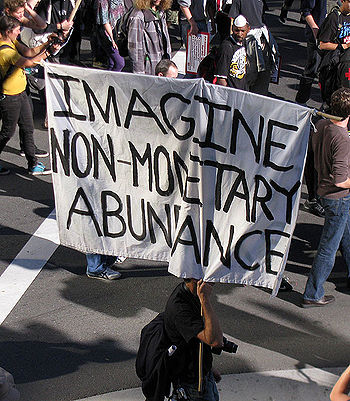
When I wasn’t working one of my many part-time jobs and hustles, I was pushing the Occupy movement and generally enjoying the tenor of the times. I ended up spending the majority of my days at the downtown public space newly christened as Oscar Grant Plaza.(2) So many people now want to say that Occupy Oakland was a political movement, and maybe it was in the grand scheme of things, but to me it was, using Hakim Bey’s term, a temporary autonomous zone—a place free from formal structures of control—and one that had been functioning without money for days and days.
The hungry got food, and the homeless got shelter. The street kids who smoked and drank at the plaza before Occupy arrived continued to smoke and drink—and now they passed around books from the free library. People were helping each other, looking out for one another, and turning their backs on the stresses of foreclosed homes and benefit cuts. I saw people being radicalized by conversation and generosity. Kids ran through the straw spread on the ground beneath us those first days. Guitars and drums played. A woman with two kids who had been staying in a shelter got a free tent. Her kids acted like they were on a camping trip where mommy seemed less upset than usual.
I was pulled to Occupy Oakland every day. Every free moment I had, I wanted to be there. I did not want to watch TV or surf the web. I knew where I had to be. As the debates burned in the media about intent, I was so excited about what was going on in Oakland that I could barely sleep. So much charity! So much cooperation! So many informed people! And live music! And wine! And dancing! Downtown Oakland, a district that used to resemble a ghost town after 5:00 p.m., was vibrant again.
Wildly creative signs appeared throughout the weeks of Occupy Oakland. This one during the Oct. 22, 2011 march.
Photo: Chris Carlsson
When the Oakland police chief resigned on October 12, he held a press conference on the steps of City Hall. The press covered his speech but didn’t turn around and film the encampment directly behind them. By the second week, as national media started trying to fit Occupy Wall Street into their standard narratives, local Bay Area media followed their lead and began attempting to create a monolithic Occupy Oakland demographic. While we continued our good work, many of us with jobs and families at home watched the local media shift from painting us as white and middle class to painting us as white, homeless, unfocused, and violent. I knew that it was only a matter of time before this perception would overcome the reality.
The media coverage attracted the hangers-on. Black nationalists circled the perimeter like buzzards. Communists set up a table on day two, but were gone by day five. Danny Glover showed up representing the Democrats. An interfaith coalition composed of local churches came by. Even before the first major police raid, I suspected that Occupy Oakland was on borrowed time. I took my son on the second Saturday of the movement to show him the cooperative model before the growing parade of egomaniacs destroyed it.
"The Revolution Will Not Be Televised" of course.
Photo: Chris Carlsson
On October 25 at 3:45 a.m., while families slept, the Oakland Police Department stormed the Occupy camp with flash bombs, batons, and tear gas. All I could think about were my friends. I had spent at least six hours a day there for the last two weeks. History was calling, and I could not say no. I thought of all the people I’d come to admire and respect. Seeing their willingness to help, to build, I had come to love them over that time.
I’d heard that over one hundred folks had been arrested, so I went down to the rally at the Oakland Public Library to do a headcount of the true organizers, not the spokesmen. Everyone was accounted for except a guy I had nicknamed “Little Big Man.”
Little Big Man was this huge, young white guy who came up to me on the first night and said, “I don’t know my role,” with a lost look in his eyes. I didn’t know why he came to me—maybe it was the electricity of that first night, the magic that shimmered in the air—but to me, his confusion was about more than just his place in Occupy. I put my hand on his shoulder and said, “Whoever you were, you left him behind when you came here.” He looked relieved. Portly and young, I saw him as the designated “fat kid” in high school. Beaten and bullied, his eyes wavered behind wire-framed lenses. “Reinvent yourself,” I said, “create your role.” And he did! Over those first two weeks I watched him come into his own through service to other people. He fed the homeless, shelved books in the free library, pedaled the bike that charged the generators at the media center—he created a vital role for himself. He became the type of person that would throw himself on the grenade. Little Big Man got arrested. Never saw him again.
Alameda County Sheriffs stand guard over Oscar Grant Plaza hours after the 3 a.m. eviction of the Occupy Oakland camp.
Photo: Chris Carlsson
Marchers in front of Oakland Library during Oct. 25, 2011 protest of police attack on Occupy Oakland.
Photo: Chris Carlsson
I was at the march the day after the raid, organized with the intent to reclaim Oscar Grant Plaza. This was the march at which protestor Scott Olsen, a twenty-four-year-old former Marine and Iraq War veteran, would obtain a fractured skull, an injury witnesses said came from a tear gas canister fired by police. A friend of mine (a local reporter, Eric K. Arnold) and I ran ahead with our cameras to take photos of the march and to scout police positions. Whenever I ran into one of these police “flashpoints,” I’d text the location to someone in the march so they would know what to expect. The plan was to march to the Oakland Police Station and then back to Oscar Grant Plaza. There were more than one thousand marching, many of them seniors and children.
What happened was this: the Oakland Police Department would assemble at three of the four corners of an intersection, allowing the marchers in before closing off the entrance and exit. I learned later that this was known as “kettling.” What I saw were thousands of people trapped with no exit routes, and the police holding them in for longer and longer at each intersection, seemingly in an attempt to inspire frustration. I called the maneuver “shaking the hive,” and it proved effective. They would eventually release the marchers from the intersection onto any street they desired, so by the time we arrived on a narrow street just off Ninth and Broadway, two blocks away from the station and five away from the plaza, we had been totally diverted from our goal.
The cops kettled us into a side street off Ninth, and some say the group of young anarchists that call themselves the Black Bloc set off the next round of conflict by throwing blue paint balls at the riot cops. This only confirmed the Occupy Oakland image as young, white, and privileged, with parents who could afford bail. Tear gas, rubber bullets, and sound cannons with pitches so severe they caused dizziness assaulted us without warning. I saw an elderly woman caught in the crossfire and rushed to escort her to the sidewalk. As I pulled the confused, the young, and the fragile out of clouds of tear gas, I chanted, “Keep moving! Don’t fuck it up!”
Oakland riot police staging for the violence they would inflict later the same night, Oct. 25, 2011.
Photo: Chris Carlsson
I stayed as long as I could, but two cops apparently saw me as an agitator and came for me. I sprinted up the block and hopped a fence, landing on Tenth Street next to my friend David Brazil. My throat and eyes were burning as I jetted down Fourteenth and Broadway, heading for the Radio bar on Twelfth, looking for my friend Eric. Then I moved on to the Layover, an art and music lounge on Franklin. I stepped out to call my son, and when I tried to go back inside, I found they had locked the doors. I headed back to Broadway.
All the helicopters, riot cops, and TV cameras were capturing the activity of strangers. Aside from my friends “Lil Bit” and “Shake,” none of my folks were on the street. Eric had told me not to worry. “The smart ones get away,” he said, but I sent his crazy ass a text anyway. He was right. We all got away.
My body depleted of nearly all its adrenaline, thoughts kept running through my head. Like, why paint? And blue paint at that? Didn’t it just provide the police with proof of contact and permission to respond in kind? It seemed to me that sparking off the confrontation I’d just been in, penned in as we were on that tiny street off Broadway and Ninth, was only strategically advantageous for the Oakland Police.
Late afternoon, Oct. 25, 2011, marchers crisscross downtown before surging towards Oscar Grant Plaza at dusk.
Photo: Chris Carlsson
Once the “Massacre at the March,” as it became known, was covered by all of the major media outlets, Occupy Oakland became the cause célèbre all over the world. Egypt even proclaimed alliance with Occupy Oakland, and its Facebook group swelled from 500 to 5,000 overnight, making it too big to be functional.
I tell people that they missed it. Even if Occupy Oakland were to return, it wouldn’t be the same. It is international now. Michael Moore has spoken; the professionals have taken it over. The image has superseded the reality.
Oscar Grant Plaza became ossified as Occupy Oakland’s main goal, and the more the movement sold it as a fight over the plaza, the more the territory became the movement. Property battles are much easier for a plutocracy to deal with than a society that can function without its money.
To me, the Occupy movement is a simple acknowledgement of a class war that was declared against the “99%,” a war that has resulted in the dismantling of the labor movement, an escalation of the war on drugs, the growth of the prison-industrial complex, cuts in school and domestic programs, and a consolidation of wealth and power by corporations that has put them beyond the reach of any governmental body. The rich have gotten richer, the poor have gotten poorer, and ignoring it ain’t working.
After the November 2, 2011, general strike, held to call attention to corporate greed, and the consequent shutdown of the Port of Oakland by thousands of protestors, I didn’t get involved with any other direct actions. Many of my friends had moved on to more focused cells focused on separate issues such as fighting foreclosures and creating sustainable free daycare and healthcare.
As people regrouped and tried to “take back” Oscar Grant Plaza, I stressed that the more we fought for a permanent place, the more we lost our autonomy. But many of these people were new. They had only arrived after the grills had stopped cooking and the out-of-towners had undermined the local merchants’ and unions’ trust, only after a young man running for the safety of numbers had been shot a few steps away from the camp. Pundits tried to tie this young man’s shooting to Occupy Oakland, but it was an unrelated incident (he was apparently killed over a miniscule debt). The fact is, young black men are being gunned down every day in America, but it seems the only time the media notices is when it happens in the proximity of a white person. Ironically, in the end, the myth of Occupy Oakland being a “white” movement may have worked in favor of raising awareness of this sort of deplorable commonplace occurrence.
I’m not attached to any location, any name, any ethos. I built community and represented myself and my legacy through direct engagement with Occupy Oakland. I saw it. I smelled it. I tasted it. History—we made it, all of us.
Notes
1. An acronym for the Counterintelligence Program, COINTELPRO was a series of covert, and often illegal, operations carried out by the FBI from the mid-1950s until the early 1970s that aimed to disrupt, discredit, and neutralize dissident political organizations in the United States.
2. Officially known as Frank H. Ogawa Plaza, the space was renamed by members of the Occupy movement in memory of Oscar Grant, an unarmed man fatally shot by a BART police officer on New Year’s Day, 2009.
Photos from the November 2, 2011 march through Oakland at midday, and then to the Port of Oakland around 5 pm.
Photos by Chris Carlsson
<iframe width="560" height="315" src="https://www.youtube.com/embed/-Poo4Mso3sE?si=VXxDxdWEyfRUMKWG" title="YouTube video player" frameborder="0" allow="accelerometer; autoplay; clipboard-write; encrypted-media; gyroscope; picture-in-picture; web-share" referrerpolicy="strict-origin-when-cross-origin" allowfullscreen></iframe>
Video by Brandon Jourdan and Marianne Maeckelbergh, 2011

